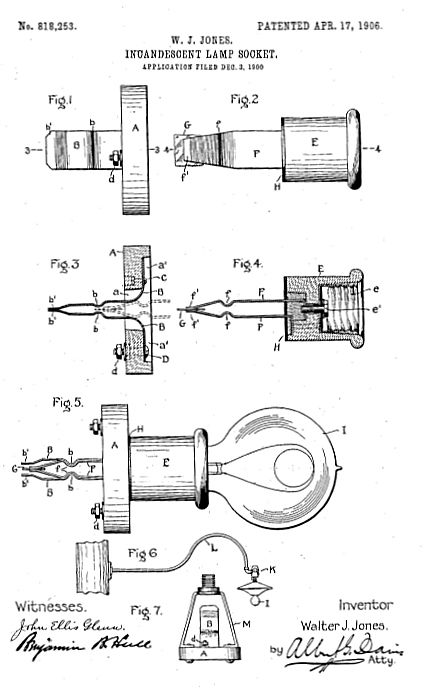When working with series street lighting circuits all you can depend on is Ohm's Law.
Parallel loads; Current increase with increased loading.
Series loads; Current is constant increased loading.
Parallel loads; Voltage is relatively constant with increased loading with increased loading.
Series loads; Voltage increases with increased loading with increased loading.
Parallel loads; Open circuit voltage normal, current zero.
Series loads; Open circuit voltage dangerously high, current normal.
Parallel loads; Overload or short circuit, dangerously high current. Safe by opening circuit.
Series loads; Overload or open circuit, dangerously high voltage. Safe by shorting transformer output.
In normal operation the voltage across each lamp was less than 100 Volts.
In the photograph you may see a small button between the ends of the bayonets.
This would short out at around 100 Volts and bypass a burnt out lamp.
The mogul lamp socket was special in that the center contact was spring loaded and had an extension tab.
When a lamp was removed the spring would force the center contact upwards until the tab made contact with the shell, shorting out the lamp holder.
Regulators were protected by a similar device but with a permanent shorting link. The button was about 3/4 inch in diameter and resembled the tire only from a toy car.
A small circular lead plug was pressed into one side of the center hole.
A number of mica washers were then inserted, the number dependent on the loaded circuit voltage.
In the event of an open circuit the current would flash over between the lead plugs or disks.
The arc would melt the lead that would flow together and short out the regulator.
All you ever wanted to know about series regulators and circuits.
There were a number of standard currents in use;
6.6 Amps, 7.2 Amps, 7.5 Amps and 20 Amps.
Current transformers (Not to be confused with CTs) could be and were used to transform from one current level to another.
20 Amp circuits were a special case.
On streets where street cars ran, the vibration from the passing street cars often caused rapid burnout. The voltage across a 20 Amp lamp was around 12 to 20 Volts depending on the lumens output.
The filament was massive. When disconnected, instead of going out immediately, the filament cooled down like a toaster element.
Compare a toaster element at about 6 Amps with a filament at 20 Amps.
The lower output lamps worked well on a 12 Volt car battery.
On some circuits the regulator output was 7.5 Amps and a small current transformer was installed in the base of each pole to transform the 7.5 Amps to 20 Amps.
There were also series mercury vapour ballasts available and used on some circuits.
The Point Grey area of Vancouver Canada was a separate municipality until it merged with Vancouver in 1929.
I had the privilege of working for a time on series street lighting with an old time who had started his career as an apprentice installing series street lighting in Point Grey municipality. He was about a year away from retirement when I worked with him.
It was a great experience.
Bill
--------------------
"Why not the best?"
Jimmy Carter



